The Pharmaceutical Glass Container Industry Analysis in Europe is estimated to be valued at USD 3.9 billion in 2025 and is projected to reach USD 6.1 billion by 2035, registering a compound annual growth rate (CAGR) of 4.5% over the forecast period.
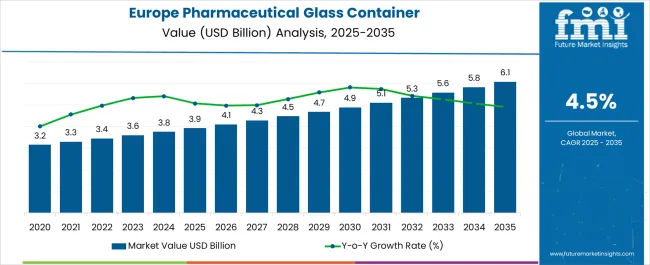
| Metric | Value |
|---|---|
| Pharmaceutical Glass Container Industry Analysis in Europe Estimated Value in (2025 E) | USD 3.9 billion |
| Pharmaceutical Glass Container Industry Analysis in Europe Forecast Value in (2035 F) | USD 6.1 billion |
| Forecast CAGR (2025 to 2035) | 4.5% |
The pharmaceutical glass container industry in Europe is experiencing robust growth. Increasing demand for injectable and parenteral drugs, stringent regulatory requirements for packaging quality, and rising focus on product safety and shelf life are driving market expansion. Current market dynamics are influenced by the prevalence of biologics and specialty pharmaceuticals, which require high-quality glass containers and closures.
Technological advancements in glass manufacturing, including improved chemical durability and breakage resistance, are enhancing product performance and compliance. The future outlook is shaped by increasing adoption of prefilled syringes, vials, and ampoules, as well as growing demand for Type 1 glass due to its high thermal and chemical resistance.
Market growth is being further supported by trends in hospital and clinical settings, where secure and reliable packaging is critical Growth rationale is based on the industry’s ability to meet strict European pharmacopoeia standards, the expanding pharmaceutical manufacturing base, and continuous innovation in closure and container design, ensuring sustained adoption and penetration across regional pharmaceutical supply chains.
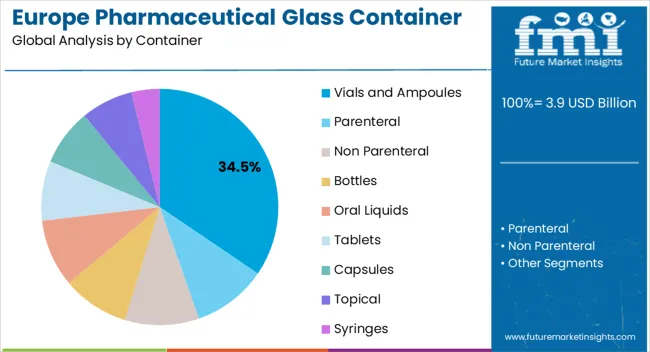
The vials and ampoules segment, representing 34.5% of the container category, has been leading due to its widespread use in injectable drugs and laboratory applications. Market preference has been reinforced by standardized sizes, compatibility with automated filling lines, and adherence to regulatory guidelines for sterility and safety.
The segment’s performance has been strengthened by consistent demand from both hospital and commercial pharmaceutical production. Manufacturing advancements have enhanced glass clarity and resistance to thermal stress, which supports extended shelf life and reduces breakage risk.
Supply chain integration and quality control measures have further solidified trust in vials and ampoules, while ongoing innovation in design and packaging efficiency continues to sustain their market share and relevance in the European pharmaceutical sector.
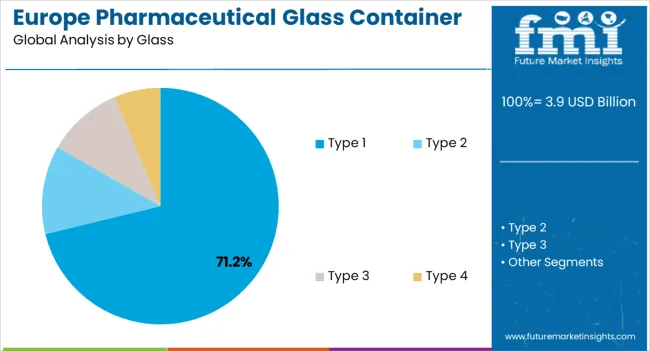
The Type 1 glass segment, accounting for 71.2% of the glass category, has maintained dominance due to its superior chemical durability, thermal resistance, and compatibility with sensitive drug formulations. Adoption has been driven by stringent European regulatory standards and the increasing prevalence of high-value biologics requiring inert packaging.
Type 1 glass ensures minimal interaction with the contents, preserving drug efficacy and safety. Production consistency, coupled with robust quality assurance protocols, has reinforced confidence among pharmaceutical manufacturers.
Advances in glass formulation and defect control have improved breakage resistance and handling efficiency The segment’s market share is expected to remain strong, supported by ongoing pharmaceutical innovation, expansion of injectable therapies, and regulatory emphasis on high-performance packaging materials.
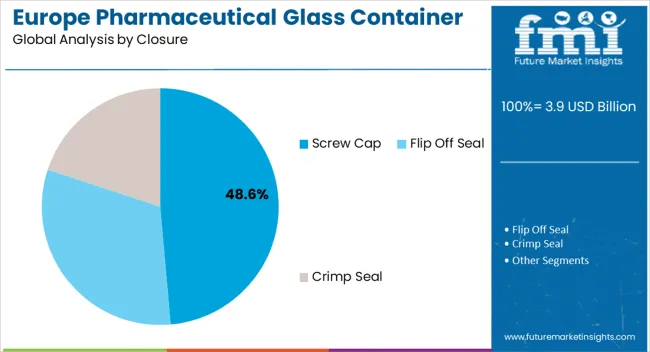
The screw cap segment, holding 48.6% of the closure category, has emerged as the leading closure type due to its reliability, ease of use, and compatibility with automated filling systems. Its adoption has been supported by effective sealing performance, ensuring product integrity and protection against contamination.
Standardization and global acceptance of screw caps have contributed to widespread use across hospital, clinical, and commercial pharmaceutical applications. Manufacturing advancements in materials and sealing technologies have enhanced durability, chemical resistance, and regulatory compliance.
The segment’s market share is sustained by continuous demand for secure, user-friendly, and cost-effective closures, while innovation in tamper-evident and child-resistant designs is expected to reinforce its position in the European pharmaceutical glass container market.
Revenue to Expand About 1.6X in Europe through 2035
Europe pharmaceutical glass container business revenue is projected to expand around 1.6X through 2035, amid a 0.5% increase in anticipated CAGR compared to the historical one. This is attributable to the growing prevalence of chronic diseases, increasing medical spending, and rising new drug development activities.
Europe is witnessing a rapid expansion of the pharmaceutical sector on the back of rising cases of chronic diseases and an increasing geriatric population. This is expected to uplift the demand for pharmaceutical glass containers as they are considered safe and reliable pharmaceutical packaging options.
Other Trends in the Pharmaceutical Glass Container Business in Europe include:
Bottles, Vials, and Ampoules Segments to Collectively Hold Over 91% Share
As per the new Europe pharmaceutical glass container industry analysis, bottles and vials & ampoules segments are anticipated to hold over 91% value share in 2035 collectively. This is due to the rising usage of bottles, vials, and ampoules for packaging a wide variety of pharmaceutical formulations.
Glass bottles have become highly suitable packaging for storing, protecting, and transporting medications. These are set to be widely used for oral drugs, syrups, and other liquid formulations.
Glass vials are also increasingly used to package injectable drugs, while glass ampoules are employed for liquid medications. Hence, the growing usage of glass-based bottles, vials, and ampoules for packaging drugs and medicines due to their several benefits will boost the target segments.
Germany to Lead in Terms of Pharmaceutical Glass Container Consumption
Germany is set to lead Europe in terms of pharmaceutical glass container consumption. As per the latest report, Germany will likely hold a dominant value share of around 23.9% by 2035. This is due to factors including:
Transition toward Sustainable Packaging Creating Prospects for Manufacturers
There is a growing focus on sustainability in the pharmaceutical sector across Europe amid rising levels of plastic pollution in the environment. This creates a conducive environment for the growth of the pharmaceutical glass container business, as these are seen as more sustainable packaging options.
Glass is fully recyclable and can be easily recycled repeatedly without losing quality. This makes it an eco-friendlier option than other packaging materials. Amid tightening government regulations on plastic usage, businesses that provide sustainable pharmaceutical packaging, such as glass containers, are set to succeed in the assessment period.
Pharmaceutical glass containers are becoming an essential part of the pharmaceutical packaging system. This is because they ensure the safety, efficacy, and stability of pharmaceutical products. They are set to be designed to both uphold high medical standards and ergonomically protect the integrity of a product.
The ability of pharmaceutical glass containers to safely and effectively protect and deliver a wide variety of pharmaceutical products is set to boost their demand across Europe. These glass containers are giving tough competition to pharmaceutical containers, including plastic vials, due to their sustainable nature and other advantages.
The availability of pharmaceutical glass containers in a variety of shapes and sizes is another key factor fueling their adoption in the pharmaceutical sector. These containers come in different forms, including bottles, ampoules, vials, and jars.
The growing popularity of biopharmaceutical and specialty drugs is anticipated to drive sales of pharmaceutical glass containers. This is because these drugs often need specialized packaging solutions, such as glass containers, which can help maintain their integrity.
Top companies are also innovating to develop novel pharmaceutical glass containers, such as coated ones. Several companies are focusing on introducing amber glass containers to protect light-sensitive pharmaceutical products. This will likely boost the total revenue in Europe.
Sales of pharmaceutical glass containers in Europe grew at a CAGR of 4.2% during the historical period. Total sales value in the region increased from USD 2,916.2 million in 2020 to USD 3,437 million in 2025.
Over the forecast period, pharmaceutical glass container sales in Europe will likely soar at 4.7% CAGR. It is expected to attain a valuation of USD 5,656.8 million by 2035.
| Historical CAGR (2020 to 2025) | 4.2% |
|---|---|
| Forecast CAGR (2025 to 2035) | 4.7% |
The rise of biopharmaceuticals and biologics is creating a high demand for specialized glass containers that can accommodate these complex and sensitive formulations. These containers need to maintain the stability and potency of such advanced therapies.
Rising healthcare demands would drive the need for pharmaceutical glass packaging. The expanding pharmaceutical sector relies on these containers to maintain drug effectiveness and quality.
The growing demand for pharmaceutical products is expected to bolster sales of pharmaceutical glass containers. This is because several pharmaceutical formulations require high-quality packaging and glass-based containers offer excellent protective properties, such as chemically inert and rigid.
There is a growing emphasis on sustainable packaging solutions in the pharmaceutical sector. Manufacturers are focusing on developing eco-friendly containers, such as glass-based ones, that reduce waste generation and have a minimal environmental impact. The growing usage of these sustainable packaging solutions is set to boost revenue across Europe.
The table presents the expected CAGR for the Europe pharmaceutical glass container business over several semi-annual periods from 2025 to 2035. In the first half (H1) of the decade from 2025 to 2035, the business is expected to surge at a CAGR of 4.4%, followed by a slightly lower growth rate of 4.2% in the second half (H2) of the same decade.
Moving into the subsequent period, from H1 2025 to H2 2035, the CAGR is projected to increase slightly to 5.0% in the first half and remain moderate at 4.7% in the second half. These values offer insights into the anticipated growth trends for the Europe pharmaceutical glass container business, aiding stakeholders and investors in making informed decisions regarding investments & strategies.
| Particular | Value-based CAGR |
|---|---|
| H1 (2025 to 2035) | 4.4% |
| H2 (2025 to 2035) | 4.2% |
| H1 (2025 to 2035) | 5.0% |
| H2 (2025 to 2035) | 4.7% |
High Adoption of Glass Vials to Boost Sales across Europe
To offer and maintain the requisite quality of sensitive medicines and drugs, pharmaceutical producers must act. Drugs and medicines lose a handful of their potency when they come into contact with drug storage containers made of metals such as aluminum, which lend flavor to the drugs. This puts pharmaceutical glass containers, including glass vials, into the spotlight.
The drug stored inside the glass vials makes them non-reactive. These glass vials are also easy to clean and dust-resistant. The popularity of glass vials is increasing due to their several advantages, such as longer shelf lives and contamination-free storage.
Glass vials are becoming increasingly popular among a variety of end users, including hospitals, medical facilities, and pharmaceutical companies. This is expected to boost sales of pharmaceutical glass vials and revenue in Europe.
As glass vials are readily recyclable, they are seen as an environmentally benign material, which ultimately increases their popularity. The Europe pharmaceutical glass container business will expand rapidly due to end customers' shifting preference from conventional containers and vials to glass vials.
Increasing Drug Development and Manufacturing Activities to Elevate Demand
The pharmaceutical glass container business in Europe is being propelled by the burgeoning pharmaceutical production and development sector. A greater need for high-quality and customized glass containers for packaging sensitive pharmaceuticals and biologics has arisen due to increased pharmaceutical research and rising demand for medications and treatments.
Pharmaceutical firms are investing significantly in creating novel medication formulations, such as biologics, sterile injectables, and other cutting-edge treatments. More companies are using specialized pharmaceutical glass containers as a result of the requirement to guarantee medicine stability, avoid contamination, and adhere to regulatory norms.
Stringent Regulatory Guidelines in Europe Bolstering Sales
Adherence to strict regulatory criteria is essential in the Europe pharmaceutical sector to maintain product quality and assure patient safety. For this purpose, pharmaceutical companies are employing safe and sterile packaging solutions such as glass containers.
The requirement for packing materials that reduce the danger of contamination and chemical interactions is further highlighted by the strict regulatory framework imposed by the European Union (EU). These include good manufacturing practices and quality management systems. Driven by this, pharmaceutical glass container consumption is set to rise rapidly in Europe.
Pharmaceutical glass containers are becoming a popular choice in Europe. This is due to their superior chemical stability, low extractable and leachable profiles, and compatibility with a variety of medication formulations.
Pharmaceutical glass containers would show a dedication to the strict requirements of the region as pharmaceutical businesses negotiate the complicated terrain of legislation. These containers are crucial in protecting drug goods from outside influences, helping to establish Europe as a global leader in manufacturing safe and effective medications.
Overview of Restrictive Factors for Europe Pharmaceutical Glass Container Space
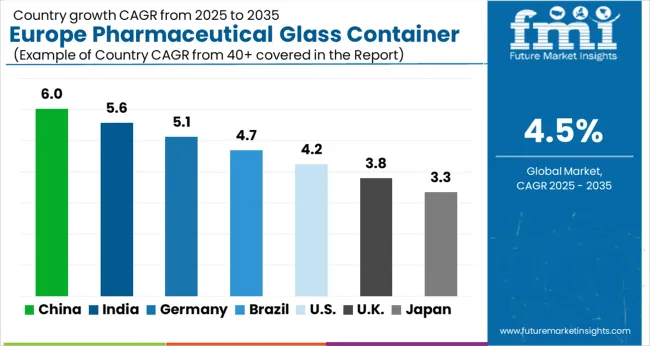
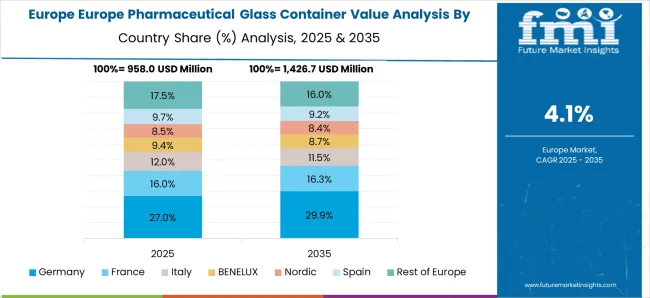
As per the latest Europe pharmaceutical glass container industry analysis, Germany is anticipated to hold around 25% of the share in Europe by 2025. Over the forecast period, pharmaceutical glass container demand in Germany is predicted to rise at 4.1% CAGR.
Several factors are expected to drive the demand for pharmaceutical glass containers in Germany through 2035. These include the expanding pharmaceutical sector, rising drug development activities, and the presence of leading pharmaceutical giants.
In Europe, Germany has a strong pharmaceutical and biotechnology sector, with several indigenous enterprises conducting pharmaceutical product development. This is creating a high demand for pharmaceutical packaging, such as pharmaceutical glass containers.
Germany is also the leader in drug development, offering attractive business solutions for foreign biotech companies, including research and development collaborations, establishing headquarters, or entering strategic partnerships. This is expected to boost the target business.
According to the report, sales of pharmaceutical glass containers in Italy are expected to soar at a CAGR of 5.0% during the assessment period. Total revenue in the country is set to reach around USD 6.1 million by 2035.
Sales in Italy are expected to be driven by factors such as the growing pharmaceutical sector, technological advancements, and the implementation of serialization and aggregation regulations.
Pharmaceutical glass containers play a crucial role in the serialization process. They are set to be used as primary packaging for drugs. Hence, serialization is directly related to pharmaceutical glass containers as they are an integral part of the packaging design that carries unique identifiers.
The United Kingdom is set to remain a highly lucrative nation for pharmaceutical glass container manufacturers across Europe. It is expected to attain a valuation of USD 929.5 million by 2035, exhibiting a CAGR of 3.6%.
Rising prevalence of chronic diseases and increasing demand for pharmaceuticals are key factors expected to drive sales growth in the United Kingdom. Similarly, the rising popularity of injectable drugs contributes to the demand for pharmaceutical containers in the country.
Pharmaceutical demand in the United Kingdom is expected to rise significantly during the forecast period, owing to the growing geriatric population and rising incidence of chronic diseases. This will likely boost pharmaceutical glass container sales in the country.
Another key factor expected to fuel demand for pharmaceutical glass containers in the United Kingdom is the rising preference for sustainable packaging. This is because both pharmaceutical companies and consumers are shifting their preference from plastic pharmaceutical packaging to glass.
Austria is forecast to become an attractive destination for pharmaceutical glass container companies. This is due to the rising popularity of injectables and biologics, increasing healthcare spending, and expansion of the generics sector.
From 2025 to 2035, pharmaceutical glass container sales in Austria are anticipated to surge at 6.0% CAGR. Total revenue in the country is set to reach around USD 177.1 million by 2035.
Demand for injectable drugs is rising significantly across Austria, and this is expected to fuel sales of pharmaceutical glass containers through 2035. This is because injectables are often packaged in syringes, vials, and ampoules.
Belgium is projected to witness steady growth during the forecast period. This is attributable to the rising focus on using sustainable pharmaceutical packaging and the growing popularity of biologics. The rising demand for glass packaging for biopharmaceutical products in Belgium is also set to aid growth.
Demand for pharmaceutical glass containers in Belgium will likely increase at 5.7% CAGR throughout the forecast period. By 2035, the total pharmaceutical glass container revenue in the country is expected to reach USD 230.7 million.
Glass is becoming an ideal packaging material for several pharmaceutical products owing to its inert nature. Leading pharmaceutical giants in Belgium are shifting their preference toward using glass containers to package a wide variety of pharmaceutical drugs. This will elevate demand in the country.
Surging demand for biologics such as vaccines and monoclonal antibodies is another prominent factor expected to boost sales in Belgium. This is because biologics are primarily packaged glass vials or syringes.
The below section predicts the vials and ampoules segment to witness a higher CAGR compared to other container types. It will likely thrive at 5.3% CAGR during the assessment period.
Based on closure, the screw cap segment is set to generate significant revenue across Europe. It is predicted to progress at a CAGR of 4.3% between 2025 and 2035.
| Container Type | Value CAGR |
|---|---|
| Vials and Ampoules | 5.3% |
| Bottles | 4.4% |
| Syringes | 4.5% |
As per the Europe pharmaceutical glass container industry analysis, the bottle segment is expected to constitute more than 65% share by the end of 2035. This is due to the high adoption of glass bottles for packing a wide variety of pharmaceutical formulations, including oral liquids, tablets, and capsules.
Among the sub-categorization, the oral liquid category holds over 50% of the share as it includes a wide variety of drug products, such as syrups, suspensions, and solutions, that are intended for oral administration. They are expected to be used for patients who have difficulty swallowing or for medications that require a more rapid onset of action.
The emerging statistics, however, estimate the vials and ampoules segment to witness a higher CAGR of 5.3% over the forecast period. It will likely hold around 1/4th of the share by 2035. This is attributable to the increasing adoption of sterile vials and other sterile primary containers and the growing demand for parenteral drugs, such as insulin and corticosteroids.
Sterile vials are set to be designed to maintain sterility throughout the entire supply chain. This would help prevent contamination and ensure that the drug product is safe for use in the pharmaceutical sector.
Healthcare professionals emphasize the importance of ensuring that patients take the right dosage of medication. This is expected to increase the popularity of pharmaceutical vials.
Constant innovations in the pharmaceutical sector, such as blow fill seal (BFS) vials and anti-counterfeit measures, are also driving the adoption of pharmaceutical vials. To gain maximum profits, key pharmaceutical glass container manufacturers are projected to improve their vials and ampoules portfolios.
| Product Type | Value CAGR |
|---|---|
| Screw Cap | 4.3% |
| Flip Off Seal | 5.0% |
| Crimp Seal | 5.5% |
Based on closure, the screw cap segment is projected to hold about 60% of value share by 2035. The target segment is poised to exhibit a CAGR of 4.3% during the forecast period. This is due to the rising adoption of pharmaceutical screw caps to package a variety of products.
Screw caps are set to be widely used in the pharmaceutical sector to protect medicinal supplies. They are anticipated to be designed to provide a secure and tamper-evident seal, thereby protecting the contents from contamination.
Screw caps would act as a child-proof mechanism and promote intuitive and precise dosage dispensing. Their ability to create an airtight barrier that shields the contents from oxygen and extends product shelf life would expand use.
The growing usage of screw caps, such as standard screw caps and child-resistant screw caps, will likely boost the target segment through 2035. Screw caps have a wider range of chemical compatibility and are the most temperature-tolerant plastic closures, which makes them ideal pharmaceutical closure types.
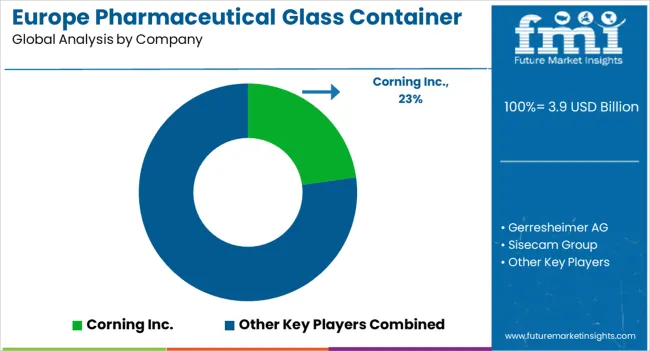
Leading pharmaceutical glass container manufacturers are focusing on developing innovations and advancements to boost their sales. They are also implementing strategies such as mergers, acquisitions, partnerships, facility expansions, and distribution agreements.
Recent Developments:
| Attribute | Details |
|---|---|
| Estimated Value (2025) | USD 3.9 billion |
| Projected Value (2035) | USD 6.1 billion |
| Anticipated Growth Rate (2025 to 2035) | 4.5% CAGR |
| Historical Data | 2020 to 2025 |
| Forecast Period | 2025 to 2035 |
| Quantitative Units | Value (USD million) |
| Segments Covered | Container, Type of Glass, Closure, Forming Process, Country |
| Key Companies Profiled | Corning Inc.; Gerresheimer AG; Sisecam Group; Nipro Corp.; West Pharmaceutical Services; Ardagh Group; Schott AG; Piramal Enterprise Ltd.; Beaston Clark Ltd.; Nekem Packaging; SGD Pharma; Stolzle Glass Group; Origin Pharma Packaging |
| Report Coverage | Revenue Forecast, Volume Forecast, Company Ranking, Competitive Landscape, Growth Factors, Trends and Pricing Analysis |
The global pharmaceutical glass container industry analysis in Europe is estimated to be valued at USD 3.9 billion in 2025.
The market size for the pharmaceutical glass container industry analysis in Europe is projected to reach USD 6.1 billion by 2035.
The pharmaceutical glass container industry analysis in Europe is expected to grow at a 4.5% CAGR between 2025 and 2035.
The key product types in pharmaceutical glass container industry analysis in Europe are vials and ampoules, parenteral, non parenteral, bottles, oral liquids, tablets, capsules, topical and syringes.
In terms of glass, type 1 segment to command 71.2% share in the pharmaceutical glass container industry analysis in Europe in 2025.






Full Research Suite comprises of:
Market outlook & trends analysis
Interviews & case studies
Strategic recommendations
Vendor profiles & capabilities analysis
5-year forecasts
8 regions and 60+ country-level data splits
Market segment data splits
12 months of continuous data updates
DELIVERED AS:
PDF EXCEL ONLINE
Pharmaceutical Plastic Bottle Market Forecast and Outlook 2025 to 2035
Pharmaceutical Grade Sodium Carbonate Market Forecast and Outlook 2025 to 2035
Pharmaceutical Grade Sodium Chloride Market Size and Share Forecast Outlook 2025 to 2035
Pharmaceutical Plastic Pots Market Size and Share Forecast Outlook 2025 to 2035
Pharmaceuticals Pouch Market Size and Share Forecast Outlook 2025 to 2035
Pharmaceutical Liquid Prefilters Market Size and Share Forecast Outlook 2025 to 2035
Pharmaceutical Grade P-Toluenesulfonic Acid Market Size and Share Forecast Outlook 2025 to 2035
Pharmaceuticals Preservative Market Size and Share Forecast Outlook 2025 to 2035
Pharmaceutical Track and Trace Systems Market Size and Share Forecast Outlook 2025 to 2035
Pharmaceutical Vials Market Size and Share Forecast Outlook 2025 to 2035
Pharmaceutical Logistics Market Size and Share Forecast Outlook 2025 to 2035
Pharmaceutical Lactose Market Analysis - Size, Share, & Forecast Outlook 2025 to 2035
Pharmaceutical Tubes Market Analysis Size, Share & Forecast 2025 to 2035
Pharmaceutical Filtration Market Growth - Trends & Forecast 2025 to 2035
Pharmaceutical Lipids Market Report - Growth, Demand & Forecast 2025 to 2035
Pharmaceuticals Grade Sodium Bicarbonate Market Insights - Size, Share & Industry Growth 2025 to 2035
Pharmaceutical Solvents Market Insights - Size, Share & Industry Growth 2025 to 2035
Pharmaceutical Caps and Closures Market – Trends & Forecast 2025 to 2035
Global Pharmaceutical Drug Delivery Market Analysis – Size, Share & Forecast 2025 to 2035
Pharmaceutical Grade Washer Market Trends – Insights & Forecast 2024-2034

Thank you!
You will receive an email from our Business Development Manager. Please be sure to check your SPAM/JUNK folder too.
Chat With
MaRIA